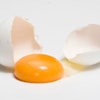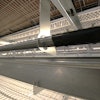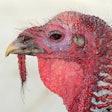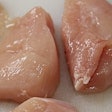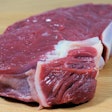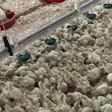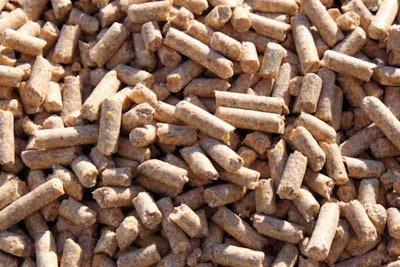
Pelleting of complete diets for all monogastric species involves steam-conditioning of the mixed mash followed by compaction through a die. The technological aspects of this feed pellet preparation method are beyond the scope of this discussion (and of my expertise), but benefits and issues of using animal feed pellets are not. So we shall begin straight away with a list of benefits that make pelleting an interesting and often confusing topic of discussion among producers and nutrition suppliers.
The benefits of pelleting in terms of feed quality are:
- Reduced volume for transportation
- Reduced dust generation
- Less feed separation
- Better flowing characteristics compared to meal diets
When it comes to animal performance, pellets offer the benefits of:
- Reduced feed wastage
- Increased nutrient intake because of reduced volume
- Improved nutrient digestibility due to thermal processing of starch and protein
- Reduced nutrient waste in manure
A combination of these factors usually improves growth rate and feed efficiency by about 10 percent. Animals with a capacity for productive performance that exceeds their capacity for feed intake are those most likely to benefit the most from pelleting, such as young animals and those in heavy reproductive phases. As the beneficial effects of pelleting are likely to decrease in animals of advanced age or less demanding reproductive phases, pelleting cost must be weighed against benefits. As a rule of thumb, for pelleting to be cost-effective, the percentage increase in feed cost due to pelleting must be less than the percentage improvement in observed feed efficiency.
How feeds are pelleted
During steam-conditioning, feed is exposed to relative high levels of humidity and increased temperature. Usually, 2 to 6 percent moisture is added to the mash during conditioning at temperatures that range from 60 to 90 C for several seconds to more than 20 minutes. In general, for each degree change in moisture of the mash due to condensation of steam, temperature increases about 20 C. Extremely high temperatures also develop during pellet formation due to friction with the die walls as the conditioned mash is forced through die openings. Therefore, there is an increased risk of formation of Maillard reaction products during the entire process of pelleting.
Learn more: The Maillard reaction’s impact on animal nutrition
In feeds that are relatively rich in dairy products (lactose is a reducing sugar) and protein sources including free amino acids, the risk of reduced protein digestibility is genuine but has received little attention from the scientific community. Pelleting also increases starch gelatinization from about 10 to 12 percent in the raw material, to approximately 25 percent during conditioning, to above 40 percent after pellet formation. Increased starch gelatinization improves pellet durability but it also increases pellet hardness.
Pellet quality issues
Pellet quality has been traditionally associated with durability, a desirable trait in pelleted diets as it reduces dust and feed/nutrient separation. A pellet durability index over 90 percent (i.e., less than 10 percent fines in the diet) is used today as a target for pelleted diets. A durable pellet is less likely to break during handling and transportation, and as a result, fewer fines are produced. An increased concentration of fine particles in feed not only increases the probability of feeder bridging, but it also increases feed wastage.
The most common way of increasing pellet durability is by increasing pellet hardness. Hard pellets are produced by a combination of ingredient selection, mash conditioning and application of pellet binders. However, pellet durability is not always the best criterion for pellet quality because very young animals appear to benefit from soft pellets or even crumbled pellets (both of which contain a higher amount of fines). It has been often suggested that young animals prefer small pellets due to their smaller mouth volume, but in reality, it has to do with their ability to either chew (pigs) or pick up and swallow (birds) the larger pellets rather than eat a mouthful of them.
Crumbles
Crumbles are a further step in the production of pellets. They are produced by passing cooled pellets between two rolls. Hammermill-produced pellets or soft-short pellets are not recommended as ways of producing crumbles. Studies on the effects of crumbling on performance in young animals remain scarce and contradictory. Field observations are equally contradictory. Results are probably confounded by initial pellet hardness and amount of fines generated during crumbling. It is safe to assume that crumbles are preferable over hard pellets, especially for young animals, but their benefits may be rapidly lost as fines increase due to excessive crumbling. Because there is additional cost in manufacturing crumbles, their potential benefits should be weighed against the extra cost.
Crumbles may be beneficial as the first diet post-weaning or as a creep diet when they are offered on floor-mats. They are also used widely as the first placement diet for chicks. Crumbles often offer the benefits of a meal while conditioning young animals to receiving pellets later. Crumbling may also offer benefits when a portion of the diet (usually the specialty ingredients) is crumbled and then mixed with finely ground cereals and protein sources to be offered as a meal. Dairy products and other powdered ingredients usually reduce flowability of complete diets in meal form, and thus a mix of crumbles and finely ground ingredients flows easier and prevents feeder bridging.
Why is pelleting resisted as a feed preparation method?
With so many beneficial effects of pelleting, it is reasonable to question the lack of widespread use of this feed preparation method. There are two main objections.
- Cost of equipment. This is the main reason why some feed compounders feel they should stay away from such technological advancement. On top of that, the cost of energy to operate such machinery and that of labor usually exceeds any benefits. Thus, pelleting is only used by large feed compounders and usually as part of their marketing program to help them differentiate from competition or home-mixed feeds.
- Lack of sophisticated labor. Here, it is the realm of home-mixers that draws back from pelleting feeds. Good pellets require at least one person being highly trained, and such a person is usually hard to find. It is not as difficult to train one, however, and some pellet machinery suppliers can help toward this direction.
At the end, the reduced return against investment as animal age progresses makes pelleting an unprofitable business, one that suffers greatly from an unstable energy and ingredient global market. Thus, pelleting is often recommended for specialty diets that allow a higher margin for feed compounders or provide the best return in terms of animal performance for home-mixers. It is only large-scale animal production operations that can employ pelleting in all phases of production and benefit from diminishing returns, even at the least profitable phases by sheer amount of volume.
